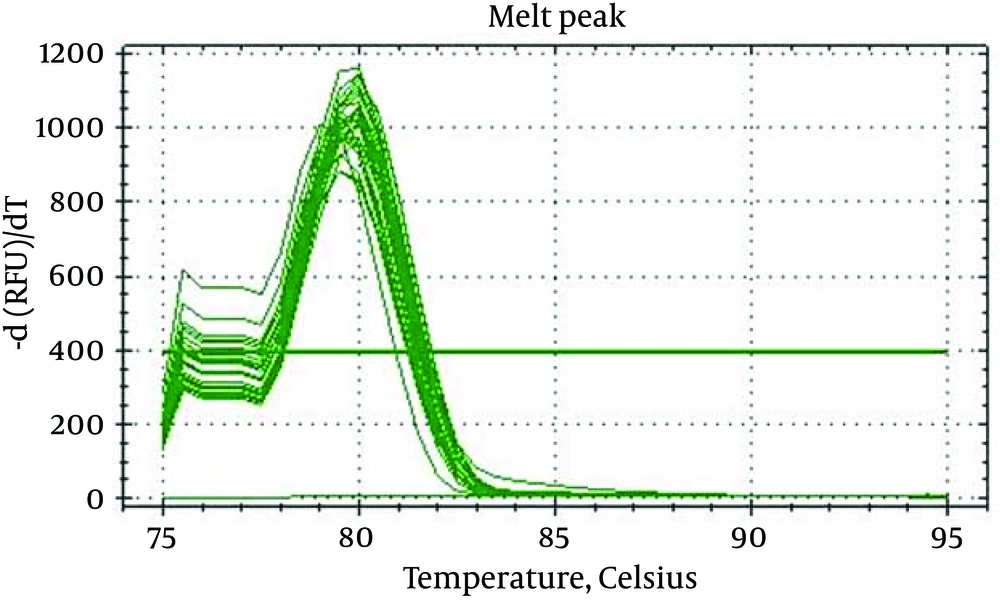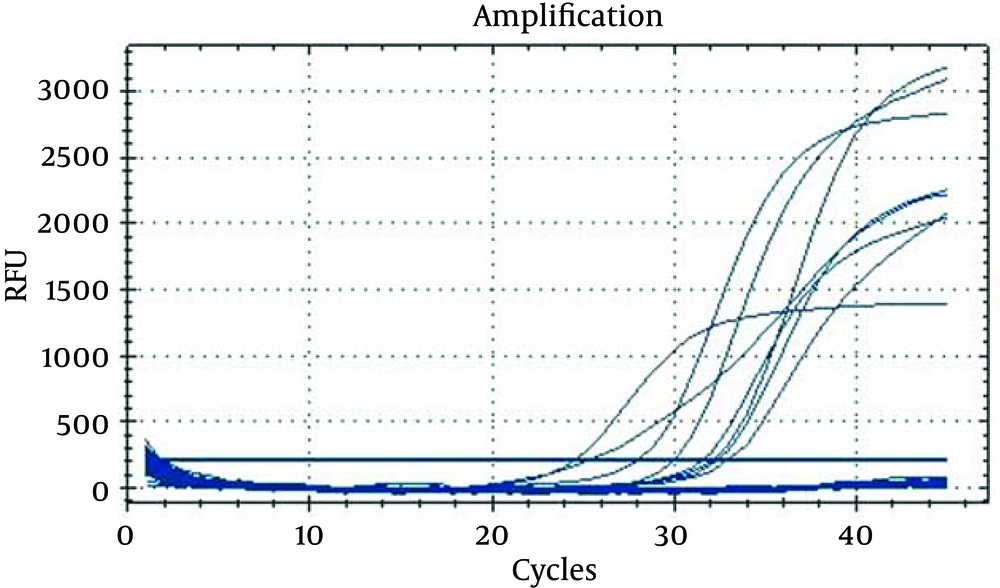1. Background
Clonal proliferation of histiocytes was first reported in Langerhans cell histiocytosis (LCH) by William et al., in 1994 (1). Langerhans cells are a type of non-lymphoid mononuclear cells that are involved in inflammatory responses and also, in neoplastic processes. They are immature dendritic cells, which express lysosomal enzymes, CD1a and S100 protein and, ultrastructurally, contain the racket shaped organelles of Birbeck granules (2). The etiology of LCH is unknown. However, in addition to other environmental factors, a possible etiologic link between viruses or vaccination and LCH has been proposed (3, 4). The Cytomegalovirus (CMV), which can infect dendritic cells and Langerhans cells (5-7), was detected in 30% of LCH patients by Kawakubo et al. (8), indicating that the release of cytokines stimulates Langerhans cell growth and induction of LCH.
A series of studies, from various parts of the world, have reported the association of Epstein-Barr virus (EBV) infection with several malignancies and LCH, representing a possible etiologic role or contribution to its pathophysiology (3, 4, 9-12). However, other studies have failed to support these findings and the possible etiologic role of EBV and other viruses in LCH remains debated (13-16). The possible association of LCH and viruses has not been previously investigated in Iranian children.
2. Objectives
Considering the fact that vaccination or early diagnosis and treatment of EBV, could be of importance in the management of LCH, we investigated the presence of EBV in Iranian children with LCH.
3. Patients and Methods
3.1. Patients and Controls
Formalin-fixed, paraffin-embedded (FFPE) tissue samples of 30 patients, with pathologic diagnosis of LCH, were extracted from the archive of the Pathology Department of Mofid Children’s Hospital in Tehran, Iran, (one of the national referral centers) for a 10-year period (2002 ‒ 2012). The diagnosis of LCH was made by a pediatric pathologist, using the histological criteria, mentioned in the pathology textbooks, i.e. granulomas composed of Langerhans cells with typical grooved nuclei, mixed with eosinophils and other inflammatory cells. The diagnoses were confirmed using immunohistochemical technique for CD1a, S100 protein and CD68, when available. After examination of the slides by light microscopy, the tissues with adequate amount of tumoral tissue were used in the study and tissues with too small tumors were excluded. All patients were Iranian and the age ranged between 2 months and 10 years. Thirty tissue samples, with non-LCH diagnosis, who were operated for reasons, other than infectious diseases, were also selected from the files of the Pathology Department (between the years 2002 and 2012), as controls (age and tissue-matched to LCH cases). These patients were operated for reasons such as hemangioma, cystic hygroma, osteochondroma, dermatitis, emphysema, pilonidal disease, soft tissue cysts, enlarged reactive nodes, anal fissure etc. The criterion for inclusion of tissue in control group was absence of clinical and microscopic evidence for LCH or any other tumor.
3.2. Paraffin-Embedded Tissue Section Preparation and DNA Extraction
The 5 µm-thick tissue sections were cut from paraffin-embedded blocks, on a microtome, and put into sterile screw-cap tubes. It is necessary to completely remove the embedding material before DNA extraction. The xylene and alcohol solutions were used to deparaffinization and rehydration of the tissue sections. Then, the sections were lysed by a tissue lysis buffer and proteinase K. The samples were subjected to DNA extraction, when the tissues were dissolved. The DNA was extracted from lysed-tissue sample, according to the company’s instructions (RTP® DNA/ RNA Virus Mini Kit procedure; Stratec Molecular GmbH, Berlin, Germany). The extracted nucleic acids were stored at -20°C, until they were tested by polymerase chain reaction (PCR).
3.3. Polymerase Chain Reaction
After quality control of the extracted DNA, by using SybrGreen Real-Time PCR (RT-PCR)-Melting curve for beta globin gene (Figure 1), the TaqMan method was applied to detect EBV genome, as qualitative RT-PCR (Figure 2). To detect EBV, RT-PCR was performed using BamH1W EBV sequence primer sets, amplifying 84 bp gene region of the virus genome (ebv-f ; 5'-GCAGCCGCCCAGTCTCT-3'), (ebv-r; 5'- ACAGACAGTGCACAGGAGCCT-3'), with an internal probe (ebv-p; 5'-FAM- AAAAGCTGGCGCCCTTGCCTG -BHQ1-3') (17). The amplification was performed in reaction volumes of 20 μL, under the following conditions: first, the samples underwent denaturation at 94°C, for 10 minutes, followed by denaturation at 94°C, for 10 seconds, followed by annealing and extension at 60°C, for one minute, repeated for 50 cycles. The RT-PCR System CFX-96 (Bio-Rad Laboratories, Hercules, CA, USA) with HS Prime Taq Premix TaqMan reagent (Genetbio, Chungcheongnam-Do, South Korea) was used in RT-PCR assay. The limit detection of 15 genome copies of EBV, per reaction, was determined by the RT-PCR assay, using the serial dilutions of AmpliRun® EBV DNA control (Vircell S.L., Granada, Spain).
3.4. Statistical and Ethical Considerations
The achieved data were compared by using Chi-Square or Fisher’s exact test. A P < 0.05 was considered to indicate statistical significance. In this study, no ethical issues were involved. Only the pathology reports were reviewed, retrospectively, and the patients were anonymous. The articles used as references are valid and the data taken are reported unchanged.
4. Results
Thirty patients with a pathologic diagnosis of LCH were included in this study. All patients were Iranian (16 male and 14 female) and the age ranged between 2 months and 10 years. Age, sex and biopsy site of all patients are shown in Table 1. Thirty tissue samples, with non LCH diagnosis, were also selected, as controls (age and tissue-matched to LCH cases). The EBV DNA was detected qualitatively, in 19 LCH patients (63.33%) out of 30 cases (positive results in 63.33% and negative results in 36.67%). In the control group, we detected EBV in eight (26.7%) samples, out of a total of 30 (positive results in 26.7% and negative results in 73.3% of controls) with an OR: 4.75; 95%CI: 1.58 ‒ 14.25 and P = 0.004, which shows a significant difference of EBV prevalence results between LCH patients and controls. The LCH patients, with positive result for EBV presence, included 11 male and eight female patients (Table 1).
| Age | Gender | Clinic /Biopsy Site | EBV |
|---|---|---|---|
| 2, y | Female | Lymph node | + |
| 2, y | Male | Mediastinal and neck mass | + |
| 10, mo | Male | Skin | - |
| 1, y | Male | Soft tissue, scalp mass | + |
| 2, y | Male | Frontal bone | + |
| 11, mo | Male | Mastoid bone | + |
| 1, y | Female | Skin, chest wall | + |
| 3, y | Male | Iliac bone | + |
| 6, y | Female | Proximal tibia | + |
| 10, y | Male | Skull and soft tissue | - |
| 2, y | Female | Parietal bone and soft tissue | - |
| 2, y | Male | Skin | + |
| 8, y | Male | Soft tissue scalp | + |
| 2, y | Female | Soft tissue submandibular | - |
| 2, y | Male | Vertebral bone | + |
| 7, y | Male | Clavicle and soft tissue | + |
| 15, mo | Male | Abdominal mass | - |
| 4, y | Female | Base of skull | + |
| 2.5, y | Female | Right lobe of lung | + |
| 8, y | Female | Skin, abdomen | - |
| 2, mo | Female | Soft tissue | + |
| 2, y | Male | Soft tissue scalp | + |
| 3, y | Female | Frontal bone and soft tissue | - |
| 3, y | Female | Soft tissue scalp | - |
| 2, y | Female | Metatarsal bone | - |
| 16, mo | Male | Skin | + |
| 4, mo | Female | Skin | + |
| 1, y | Female | skin | + |
| 1.5, y | Male | Soft tissue scalp | - |
| 7, y | Male | Soft tissue perianal | - |
Age, Sex and Biopsy Site of Patients
5. Discussion
Considering the fact that LCH could have an etiologic association with viruses, as suggested by previous studies (3, 4, 8, 10), this study was conducted due to the lack of information about such a possible link in Iranian children, in English medical literature. The LCH, a clonal proliferation of histiocytes, is a rare disease, mostly affecting children younger than five years and presents as three overlapping clinical syndromes (Letterer-Siwe disease, Hand-Schüller-Christian disease and solitary eosinophilic granuloma) (2). Histological findings are the same, in various tissues, characterized by granulomas composed of a mixture of Langerhans cells, macrophages, eosinophils, multinucleated giant cells and lymphocytes (18, 19). The prognosis of LCH is influenced by the involved organs and the age. Most adult patients, with lung involvement, usually have an indolent course of regress, whereas children need to be treated by steroids and chemotherapy (20-23).
Although the etiology is still unknown, however, environmental agents and viruses, especially EBV, or vaccination, have been proposed to play a role in the pathogenesis of LCH (3, 4). The role of EBV, as the etiologic agent of several malignancies is known and Herpes viruses are shown to be responsible for persistent infection (9, 11, 12). In addition, EBV and CMV are considered to be responsible for the hemophagocytic syndromes in human, with several inherited immunodeficiencies (24, 25). The EBV is shown to invade monocytes and Langerhans cells, during the course of infection (26, 27).
Kawakubo et al. (8) detected CMV in lesional Langerhans cells, in 30% of 29 patients, by immunochemistry (IHC), in situ hybridization (ISH), and PCR and suggested that release of cytokines could stimulate proliferation of Langerhans cells and induce LCH. The associations of EBV infection with LCH have been investigated in different reports, suggesting a possible etiologic role or contribution to its pathophysiology (3, 4, 10). McClain et al. (14) findings, however, did not support the etiologic role for adenovirus, CMV, EBV, HSV, HHV-6, HIV, human T-cell leukemia virus types I and II and parvovirus, in 56 cases of LCH, using ISH and PCR technique. Jeziorski et al. (13) also failed to find evidence of EBV, CMV, or HHV-6 in the pathogenesis of LCH. The possible etiologic role of EBV and other viruses, in LCH, is still to be proved.
We detected EBV DNA in 19 (63.33%) out of 30 patients with LCH. The positive result in eight of the control samples (26.7%) could be attributed to a coincidence. The P = 0.004 and OR: 4.75; 95%CI: 1.58 ‒ 14.25 support the hypothesis of a possible role for EBV in the pathogenesis of LCH disease, which is in concordance with several other results, reported in the literature (3, 4, 10). In previous studies (3, 4, 10, 14, 15) authors declared no limitations and the methods used included serology, IHC, ISH, and PCR. However, IHC and ISH for EBV were not available to be employed in our study and the patients were not checked for the evidence of EBV infection, serologically (limitations in our study).
The importance of our study is that it is the first study performed in Iran, on this subject. Although we have not confirmed the presence of EBV in the Langerhans cells, by other methods, and the etiologic role of EBV cannot be proved definitively, previous positive results reported in the literature (3, 4, 10), as well as our results, with 63.33% positivity, highly support the possible contribution of EBV in development of LCH. The positive results in previous studies and our study could be of importance, because vaccination or an early diagnosis and treatment of EBV infection could prevent developing LCH in the future.

